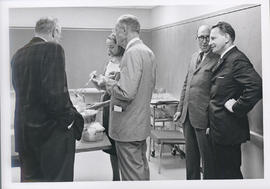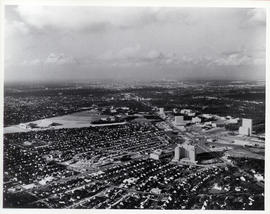This ¾” U-Matic tape contains a program titled “The Texas Medical Center” from approximately 1972. It begins with an overview of the TMC and its history. The bulk of the program is dedicated to a video tour of the TMC, offering brief characterizations of many of its hospitals and educational institutions.
The credits read: “The Texas Medical Center. This film was made possible through the cooperation of the administrators and staff of all institutions in the Texas Medical Center. Production coordinated by Texas Medical Center, Inc. with the full support and cooperation of the Council of Directors and Administrators. These people made special contributions of their technical skills: Manfred Gygli, William R. Pittman, Gloria J. Heard, Herbert R. Smith, Mario Paoloski, Ken Wiedower, Joachim Zwer. Narrated by Don Macon. Produced and Directed by Raymond O’Leary.” The video runs 29:24.
(0:01) The introduction to this program frames the Texas Medical Center as a city, explaining the variety of facilities and services there. The visuals include a mixture of images of buildings and people.
(1:18) The video tells of the origins of the TMC, going back to the trustees of the M. D. Anderson Foundation in 1941. The narrator recounts the acquisition of a 134-acre tract of land from the City of Houston. He introduces the Texas Medical Center, Inc., which he says is responsible for development and coordination across the TMC. He names the TMC leaders Dr. E. W. Bertner, Dr. Frederick Elliott, and Dr. Richard T. Eastwood. He relates that that TMC was designed to attract institutions dedicated to health ed, research, patient care and service.
(3:07) The program offers an overview of the buildings and institutions of the TMC. Hermann Hospital and its Nurses Residence predate the TMC, having been established in 1925. Baylor College of Medicine began construction in 1946. Soon came the Methodist Hospital, Shriner’s Hospital for Crippled Children, the Houston Academy of Medicine’s Jones Library Building, Texas Children’s Hospital, St. Luke’s Episcopal Hospital, The University of Texas in Houston’s M. D. Anderson Cancer Hospital and Tumor Institute, and the University of Texas Dental Branch. By 1963, new buildings included the Texas Institute for Rehabilitation and Research, the Houston Speech and Hearing Center, the Texas Research Institute for Mental Sciences, Texas Women’s University College of Nursing, the Institute of Religion and Human Development, and Ben Taub General Hospital. There were also expansions and new buildings for existing institutions.
(5:38) The program changes its focus to people in the TMC He narrators explains over 3,000 people receive care daily. In 1970, 105,000 people “lived” there, at least for a while. There were approximately 950,000 patient visits in 1970. He highlights the growth of specialized services. Approximately 15,000 people work in the TMC, and there are 3,700 volunteers.
(7:06) Ben Taub General Hospital. The video cuts to an ambulance followed by an Emergency Room scene at Ben Taub General Hospital, which is a 435-bed hospital in the Harris County Hospital District.
(8:11) City of Houston Department of Public Health. The program presents the City of Houston Department of Public Health, which offers environmental and special health services for the prevention, early detection, and treatment of disease.
(8:43) Hermann Hospital. The program notes Hermann Hospital’s community contributions. The narrator describes the modernized hospital and its affiliation with the University of Texas as a teaching hospital.
(9:15) Methodist Hospital. The program highlights Methodist’s worldwide reputation. The narrator cites its high goals in medical education, research, patient care, and advanced techniques. He mentions its strengths in internal medicine, cardiovascular surgery, neurological surgery, orthopedic surgery, and organ transplantation.
(9:53) St. Luke’s Episcopal Hospital. Cutting to a video of a birth and then showing the premature nursery, the program features St. Luke’s Episcopal Hospital. The narrator mentions other specialized facilities, such as coronary and intensive care units, a heart catheterization laboratory, a urodynamics lab, and a heart transplant unit.
(10:45) Texas Children’s Hospital. The program describes the 174-bed pediatric hospital connected to St. Luke’s and touts it hematology research laboratory.
(11:03) Texas Heart Institute. Showing a video of heart surgery, the program discusses the Texas Heart Institute.
(11:20) Shriner’s Hospital for Crippled Children. The program shows scenes of rehabilitation, including in a pool, at Shriner’s Hospital for Crippled Children.
(11:58) Houston Speech and Hearing Center. The program describes Houston Speech and Hearing Center’s programs testing, training, and treating patients, as well as teaching professionals. The narrator highlights its New Institute for Research in Human Communication and its Disorders.
(12:35) Texas Institute for Rehabilitation and Research. The program tells of the comprehensive rehabilitation care provided by the Texas Institute for Rehabilitation and Research. The narrator tells of the medical, psychological, and social care and support there.
(13:16) Texas Research Institute Mental Sciences. The program describes the Texas Research Institute for Mental Sciences’ research to solve “the problems of the mind.” It tells of research into drug abuse and the development of therapies to alleviate pain and suffering.
(14:02) M. D. Anderson Hospital and Tumor Institute. The program features the M. D. Anderson Hospital and Tumor Institute. It highlights the germ-free environments of Life Island and the Laminar air flow room.
(14:47) UT System in Houston health sciences education. The narrator notes the M. A. Anderson Hospital offers clinical residency programs, as well as pre- and post-doctoral fellowships in basic sciences.
(15:13) University of Texas in Houston School of Public Health. The program reports that the new School of Public Health mixes research plus community outreach.
(15:46) University of Texas Dental Branch. The program emphasizes the University of Texas Dental Branch’s new teaching methods, including the use of television. The narrator highlights laboratories and a 400-seat auditorium. The Postgraduate School of Dentistry offers continuing professional education. The School also offers graduate programs and advanced courses in cooperation with the Graduate School of Biomedical Sciences. The Dental Science Institute is its research arm.
(16:50) The narrator notes the Graduate School of Biomedical Sciences offers life sciences courses to engineers, scientist, technicians, doctors, and nurses. The Division of Continuing Education allows practicing physicians to obtain new medical knowledge through courses with specialists.
(17:14) University of Texas Medical School. The program introduces the University of Texas’s new Medical School in Houston, noting Hermann Hospital’s status as a primary teaching unit. The video shows images of the proposed Medical School facility, not yet completed. The narrator reports it will have 800 students once it reaches capacity. The program highlights the medical community television system, designed for sharing learning resources, with cables connected across the 22 TMC institutions through the Jones Library.
(18:14) Baylor College of Medicine. The program notes that Baylor College of Medicine is one of the top medical schools in the country. It reports Baylor’s research activities range from elemental analysis of biological compounds to the development of artificial heart components. Baylor’s research areas include lipids, virology, epidemiology, cardiovascular disease, and more. Baylor’s affiliates and teaching hospitals include Methodist Hospital, Ben Taub General Hospital, St. Luke’s Episcopal Hospital, Texas Children’s Hospital, the Veteran’s Administration Hospital, Texas Institute Rehabilitation and Research, Texas Research Institute for Mental Sciences.
(19:32) Texas Woman’s University College of Nursing. The narrator relates that TWU offers both BS and MS degrees. He adds the Schools of Occupational Therapy and Physical Therapy have undergraduate and master’s programs. The program highlights the new facilities, with an enrollment planned to grow to 500.
(20:26) Institute of Religion and Human Development. The program reports that Institute of Religion and Human Development carries out graduate education and research in ministerial service, marriage and family counseling, and post-doctoral interdisciplinary ethical studies. It adds, the Institute’s education and training balance theology and science. The program shows images of the dedication of Rothko chapel, including views of the Broken Obelisk, reflecting pool and Chapel.
(21:21) Child Care Center. The narrator explains the Child Care Center opened in April 1968 and serves seven participating hospitals, accepting children aged three months to seven years, seven days a week.
(21:58) Harris County Medical Society. As library images are onscreen, the narrator says the Harris County Medical Society created the Houston Academy of Medicine to start a medical library in 1915. The HAM-TMC Library serves all TMC institutions plus the entire Houston academic and medical community, as well as Texas and the region. He adds the University of Texas Dental Branch and M. D. Anderson Hospital also have libraries. The Library participates in MEDLARS , which provides automatic storage and retrieval of information. The TMC Common Computer and Research Facility offers computer support for TMC scientists and academic community.
(23:29) The program reflects on the growth and changes of the TMC and looks to future. It highlights new planned facilities: the TMC Bertner Street Garage, the University of Texas Medical School, the University of Texas School of Public Health, the M. D. Anderson Outpatient Clinic and Lutheran Hospital, and the Hermann Hospital Emergency Room Facility. The narrator highlights the expansion of programs to train and educate, as well as the expansion and improvement of inpatient, outpatient, and ambulatory care facilities. He calls attention to the TMC’s ongoing emphasis on cancer, heart disease, organ transplantation, mental health, virology, pharmacology, lipid research, and rehabilitation.
(26:33) The program highlights applied research in improving the delivery of health care. In doing so it points out Baylor College of Medicine and its Institute for Health Services Research, the Xerox Center, and its Community Medicine Department.
(27:01) The program describes a future focus on increasing the accessibility of high-standard health services. The narrator touts a goal of closer relationships with other hospitals and community clinics, as the program shows images of Center Pavilion Hospital, Riverside General Hospital, the St. Anthony Center, and TIRR Priester Rehabilitation Unit. The discussion moves to the prevention of sickness and injury by preserving a healthy environment and educate individuals. The narrator mentions the City of Houston Department of Public Health, University of Texas School of Public Health, and Harris County Hospital District.
(28:16) The program closes by touting the “Comprehensive medical complex which has established Goals of excellence in medical education, biomedical research, patient care and health services to the community of the nation."


































































